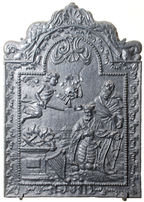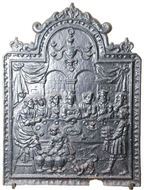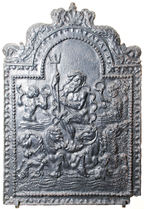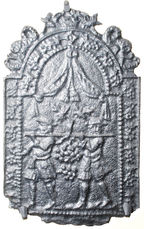-
580
Description: Arched rectangular shape with fillet edging and a repeated line and concentric semi-circle design; wicker enclosure with gate at bottom, overlaid with a lion rampant surmounted by a crown.
Notes: The enclosure is the Garden of Holland (Hollandse Tuin) and the lion the badge of the States General of the Netherlands; on the shoulders of the plate, and on three other positions equally spaced around the arch, repeated small fleurs-d-lys. Mitford collection, Petworth House.
Inscription: ...E HOV...
- Decoration tags:
- rectangular with round arch (shape)
- complex individual (edging)
- whole carved pattern
- heraldic
- text
- animals
- objects
Manufactured: in the mid- to late-17th century possibly in the Siegerland area of Germany.
Current location: Petworth House, Petworth, West Sussex, England.
Museum number: NT/PET/M/71 (part of the National Trust museum group)
- Attached to series:
- 'Dutch' Miscellaneous Firebacks
- 'Dutch' Garden of Holland firebacks
-
581
Description: Arched rectangular central panel with arch and bead-on-fillet edging; pictorial representation of a popinjay, or parrot, perched on a ring suspended by a string, the bird is clutching an olive twig, two others are below; arched rectangular border with arch; cavetto-moulded edging;to left and right, a Corinthian column with twisted lower part, and an entablature above; at top, a central flower with scrolls descending on both sides of the arch; on top, n orb, repeated on each shoulder of the plate.
Notes: The inscription is a mis-spelling of the German for parrot; the parrot on the ring perch is a popular design on Dutch firebacks. Mitford collection, Petworth House.
Copies of this fireback are known.
Inscription: PAPEGEI
- Decoration tags:
- rectangular with arch above arch (shape)
- cavetto (edging)
- whole carved pattern
- pictorial
- architectural
- text
- animals
Manufactured: in the mid- to late-17th century in the Siegerland area of Germany.
Current location: Petworth House, Petworth, West Sussex, England.
Museum number: NT/PET/M/72 (part of the National Trust museum group)
- Attached to series:
- 'Dutch' Miscellaneous Firebacks
- 'Dutch' Bird on perch firebacks
-
582
Description: Arched shape with ovolo-moulded edging; figure of a classical warrior with plumed helmet and shield, holding a sword in his right hand; inscription to left of head, probably continued to right by now no longer visible.
Notes: An unusually striking fireback of simple design. Mitford collection, Petworth House.
Inscription: ANNO ...
- Decoration tags:
- rounded arched (shape)
- ovolo (edging)
- whole carved pattern
- pictorial
- mythological
- text
- humans
Manufactured: in the mid- to late-17th century possibly in the Lorraine area of Germany.
Current location: Petworth House, Petworth, West Sussex, England.
Museum number: NT/PET/M/73 (part of the National Trust museum group)
- Attached to series:
- Miscellaneous pattern firebacks
- 'Dutch' Miscellaneous Firebacks
-
525
Description: Arched rectangular central panel with bead edging; pictorial scene of two putti bent over a central anvil, with a third putto above; below are martial symbols (cannon, banners etc.); in the arch the word 'PAX', and in the shoulders of the panel, the date in two parts; arched rectangular boreder with fillet edging, and foliage draped from the top; on top, a pomegranate to which ascends a serpent on each side, with a further pomegranate on each shoulder of the plate.
Notes: The scene may be intended to represent the infant Vulcan. Mitford collection, Petworth House.
Inscription: PAX / 16 79
- Decoration tags:
- 'Dutch' (shape)
- fillet (edging)
- whole carved pattern
- individual numbers
- pictorial
- mythological
- text
- humans
- objects
Manufactured: in 1679 possibly in the Siegerland area of Germany.
Current location: Petworth House, Petworth, West Sussex, England.
Museum number: NT/PET/M/79 (part of the National Trust museum group)
- Attached to series:
- 'Dutch' Miscellaneous Firebacks
-
527
Description: Arched rectangular central panel with bead edging terminating at the top in two loops, gather drapery and a scallop shell; two figures to the right, both bearded, the one kneeling wears cavalry armour, a cloak and a crown, the other stands behind; to the left is a sacrificial pyre on which an ox carcass burns, and above an angel carrying a sword in his right hand and a skull in his left; around this is an arched rectangular border with fillet edging and a repeated leaf pattern; on top is a scallop shell between two dolphins.
Notes: The scene illustrates the visitation of the pestilence on Israel described in 2 Samuel 24, and the sacrifice of an oxen by King David; the skull borne by the angel represents the death of those struck down by the plague. A slightly different version has the face of David looking up at the angel (no. 424). Mitford collection, Petworth House.
Copies of this fireback are known.
Manufactured: in the mid- to late-17th century in the Siegerland area of Germany.
Current location: Petworth House, Petworth, West Sussex, England.
Museum number: NT/PET/M/81 (part of the National Trust museum group)
-
528
Description: Arched rectangular central panel with bead edging; pictorial scene of seven figures, the central one crowned, seated at a table laid with cups and dishes, with two other figures, one at the front, the other to the right, serving them; below are martial symbols (cannon, banners etc.); behind the figures are two archways with drapery at the side, and a chandelier above; arched rectangular border with fillet edging, and egg-and-dart moulding on top and sides; on top, a diamond within a cartouche, and the same on each shoulder of the plate; descending from the top, a serpent on each side.
Notes: The scene is of the marriage at Cana (John 2), a biblical story often portrayed on firebacks and stoveplates. Mitford collection, Petworth House.
- Decoration tags:
- 'Dutch' (shape)
- fillet (edging)
- whole carved pattern
- pictorial
- biblical
- architectural
- humans
Manufactured: in the mid- to late-17th century in the Siegerland area of Germany.
Current location: Petworth House, Petworth, West Sussex, England.
Museum number: NT/PET/M/82 (part of the National Trust museum group)
- Attached to series:
- 'Dutch' Miscellaneous Firebacks
- New Testament firebacks
-
531
Description: Arched rectangular central panel with cavetto-moulded edging; standing female figure holding a bunch of lowers in her left hand and a pot of flowers in her ight hand; to her left a ribbed, two-handled vase of tulips, to her right a fountain with a seated figure of Neptune/Poseidon holding a trident in the right hand; the words, Fruhling, split by the figure; above, clouds; on top a scallop shell between two descending sea serpents.
Notes: The iconic figure of Spring. Mitford collection, Petworth House.
Copies of this fireback are known.
Inscription: FRVH LING
- Decoration tags:
- 'Dutch' (shape)
- double fillet (edging)
- whole carved pattern
- pictorial
- allegorical
- text
- humans
- plants
- objects
Manufactured: in the mid- to late-17th century possibly in the Siegerland area of Germany.
Current location: Petworth House, Petworth, West Sussex, England.
Museum number: NT/PET/M/84 (part of the National Trust museum group)
- Attached to series:
- 'Dutch' Miscellaneous Firebacks
-
534
Description: Arched rectangular central panel with bead-on-fillet edging; pictorial scene of a seated couple (female to the left, male to the right) holding hands; behind, to the right, a sheep by a tree; arched rectangular border with fillet edging and probable foliate decoration; on top, scallop shell between two dolphins.
Notes: The symbolism of this scene is uncertain, but likely to be of an allegorical or iconological nature. Mitford collection, Petworth House.
Manufactured: in the mid- to late-17th century possibly in the Siegerland area of Germany.
Current location: Petworth House, Petworth, West Sussex, England.
Museum number: NT/PET/M/87 (part of the National Trust museum group)
- Attached to series:
- 'Dutch' Miscellaneous Firebacks
-
536
Description: Arched rectangular shaped central panel with fillet and bead edging, Neptune/Poseidon, holding a trident in his right hand, sitting in a scallop shell drawn by four mythical sea horses, behind are two mermaids blowing horns; arched rectangular shaped border with ovolo egg and dart edging; above, two symmetrical dolphins with a clam shell between.
Notes: Typical type of fireback produced in Germany by Dutch pattern makers; the central panel was made separately for insertion into different borders; this border is a relatively simple type. Mitford collection, Petworth House.
Copies of this fireback are known.
- Decoration tags:
- 'Dutch' (shape)
- ovolo, egg and dart (edging)
- whole carved pattern
- pictorial
- biblical
- animals
- humans
Manufactured: in the mid- to late-17th century in the Siegerland area of Germany.
Current location: Petworth House, Petworth, West Sussex, England.
Museum number: NT/PET/M/90 (part of the National Trust museum group)
- Attached to series:
- 'Dutch' Miscellaneous Firebacks
- 'Dutch' Dolphin series
-
539
Description: Arched rectangular central panel with bead-on-fillet edging; pictorial scene of two men in mid-17t century dress carrying a large bunch of grapes on a pole between them, above them drapery; arched rectangular border with fillet edging; cascade of flowers around arch and down sides; on top, central crown with descending serpents, an urn on each shoulder of the plate.
Notes: The scene depicts Joshua and Caleb returning from Canaan with a bunch of grapes (Numbers 13: 23-4). Mitford collection, Petworth House.
Manufactured: in the late-17th century possibly in the Siegerland area of Germany.
Current location: Petworth House, Petworth, West Sussex, England.
Museum number: NT/PET/M/94 (part of the National Trust museum group)









